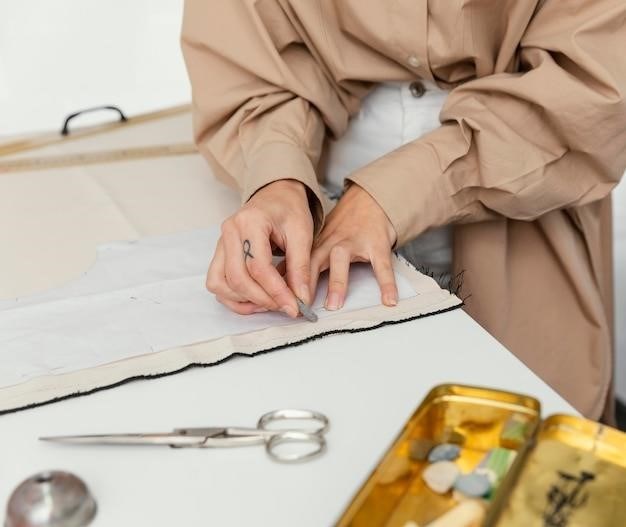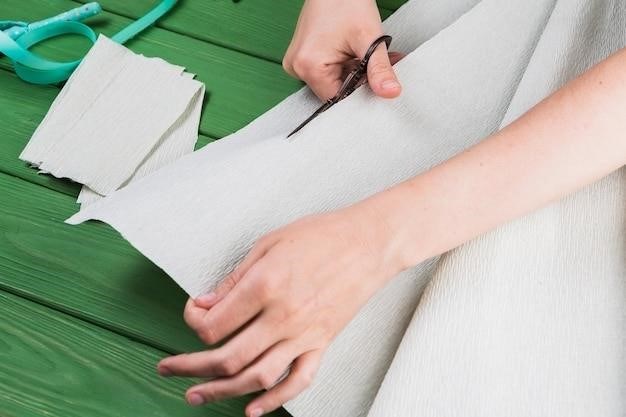French Seam Tutorial⁚ A Step-by-Step Guide
A French seam is a versatile stitch that prevents the ends of the fabric from fraying, creating a professional look; It’s a popular choice for sheer or lightweight fabrics, as it encases the raw edges within the seam, making it ideal for garments where you don’t want to see any seam allowance. This tutorial will guide you through the process of sewing a French seam step by step, enabling you to achieve a neat and durable finish for your sewing projects.
Introduction
In the world of sewing, achieving a polished and professional finish is paramount. While there are numerous seam finishes available, the French seam stands out as a technique that combines elegance and durability. This unique seam, characterized by its enclosed raw edges, offers a clean and refined aesthetic, particularly suitable for delicate fabrics like chiffon, silk, and voile. It’s also a practical choice for garments that will be subjected to frequent washing and wear, as it prevents fraying and adds strength to the seams.
This comprehensive French seam tutorial will demystify this seemingly complex technique, guiding you through each step with clear instructions and helpful tips. Whether you’re a seasoned sewer or a beginner eager to expand your skills, this guide will equip you with the knowledge and confidence to confidently incorporate French seams into your sewing projects.
Prepare to embark on a journey of sewing artistry as we explore the intricacies of this timeless seam finish. Get ready to elevate your sewing skills and create garments that exude both beauty and durability.
What is a French Seam?
A French seam is a type of seam finish that encloses the raw edges of fabric within the seam itself, resulting in a clean, professional, and durable finish. This technique is particularly popular for lightweight fabrics like chiffon, silk, and voile, where raw edges are prone to fraying. French seams are also a good choice for garments that will be subjected to frequent washing and wear, as they help prevent the seams from unraveling.
The process involves sewing the fabric twice. The first seam is sewn with the wrong sides of the fabric together, and the seam allowance is then trimmed. The fabric is then folded so that the right sides are together, and the raw edges are enclosed within the fold. The second seam is sewn along the folded edge, completely encasing the first seam and the raw edges of the fabric. This creates a strong and elegant seam finish that is invisible from the right side of the fabric.
French seams are often used in garment construction, especially for delicate fabrics, but they can also be used for other sewing projects such as home décor items, accessories, and even quilting. They add a touch of sophistication and durability to any project.
Benefits of Using a French Seam
French seams offer a range of advantages that make them a popular choice for seam finishing, particularly in garment construction. The primary benefit lies in their ability to enclose raw edges, eliminating the need for serging or other finishing techniques. This is especially valuable when working with delicate fabrics that are prone to fraying, as it prevents unraveling and maintains a clean, polished appearance. The enclosed seam also adds strength and durability, making it ideal for items that will be subjected to frequent washing or wear.
Another key advantage of French seams is their aesthetic appeal. The double-stitched construction creates a smooth, flat seam that is virtually invisible from the right side of the fabric, resulting in a professional and refined finish. This is particularly important for sheer or lightweight fabrics where any visible seam allowance can detract from the overall look. French seams also create a soft, comfortable edge that is less likely to irritate the skin, making them a good choice for garments worn close to the body.
While French seams may require a bit more time and effort than other seam finishes, the benefits they offer in terms of durability, aesthetics, and ease of care make them a worthwhile investment for any sewing project.
Materials Needed
To successfully execute a French seam, you’ll need a few essential materials. These tools will ensure a smooth and precise sewing process, resulting in a professional-looking finish. First and foremost, you’ll need a sewing machine in good working condition. It’s advisable to have a machine with a straight stitch setting, as this will provide the necessary accuracy for the double-stitched construction of the French seam. A set of sharp fabric scissors is also crucial for precise cutting of the fabric and seam allowance. These scissors will help you create clean edges, minimizing fraying and ensuring a neat appearance.
For accurate marking and pinning, you’ll need a measuring tape and a set of pins. The measuring tape will ensure precise seam allowances are maintained, while pins will hold the fabric layers securely in place during sewing. Additionally, an iron and ironing board are essential for pressing the seam allowance and creating sharp folds. A ruler and a rotary cutter are also helpful for precise trimming of the seam allowance, although a pair of sharp scissors can be used instead.
With these basic tools at your disposal, you’ll be well-equipped to tackle your French seam project, creating a durable and aesthetically pleasing finish for your sewing projects.
Step 1⁚ Pin and Sew the First Seam
Begin by placing your fabric pieces with the wrong sides facing each other. This means the raw edges of the fabric should be aligned, and the right sides of the fabric should be facing outwards. Remember that the French seam is sewn from the wrong side of the fabric, so this initial step is the opposite of how you would normally sew a seam. The general rule for a French seam is to subtract 1/4 inch from the seam allowance your pattern calls for. So, if your pattern calls for a standard 5/8-inch seam allowance, sew your seam with a 3/8-inch seam allowance. Pin the fabric pieces together along the intended seam line, ensuring the fabric layers are securely held in place. This will prevent shifting during the sewing process, resulting in a more precise and even seam.
With the fabric pinned and the sewing machine ready, carefully sew along the marked seam line. Use a straight stitch setting on your machine, maintaining a consistent speed for a smooth and even seam. As you sew, avoid pulling or stretching the fabric, as this can distort the seam and affect the final appearance. Once you’ve sewn the entire length of the seam, double-check to ensure the stitch is secure and there are no skipped stitches. You’ve now completed the first step in creating your French seam.
Step 2⁚ Trim the Seam Allowance
After sewing the first seam, it’s time to trim the seam allowance. This step is crucial for creating a neat and professional-looking French seam. Using sharp fabric scissors or a rotary cutter with a ruler and mat (for larger projects), carefully trim the seam allowance down to about 1/8 inch. Be sure to trim close to the stitching line, but avoid cutting into the stitches themselves. Trimming the seam allowance to 1/8 inch ensures that the fabric will fold over smoothly and that the seam allowance will be completely enclosed in the next step.
For corners, trim the seam allowance diagonally to reduce bulk and prevent any unwanted puckering. This technique is particularly important for items with corners, such as pillowcases, where a sharp, defined corner is desired. When trimming corners, ensure that the cut is angled, creating a slight slope, rather than a straight cut. This will ensure that the corner folds smoothly and seamlessly, without any excess fabric. Take your time and be careful, as a precise trim will contribute to a beautifully finished French seam.
Step 3⁚ Press the Seam Open
Now that the seam allowance has been trimmed, it’s time to press the seam open. This step is crucial for creating a flat and even seam, which is essential for a professional-looking French seam. Using a hot iron, gently press the seam allowance open, ensuring that the seam lies flat and even. While pressing, avoid pulling or stretching the fabric, as this can distort the seam and create puckering.
Pressing the seam open also helps to set the stitches and prevent them from loosening or unraveling. It also makes it easier to fold the fabric for the next step. For delicate fabrics, use a pressing cloth between the iron and the fabric to prevent scorching. If you’re working with a fabric that’s prone to shine, use a pressing cloth on both sides of the fabric. This will help to prevent the fabric from becoming shiny.
When pressing the seam, use an up and down motion with the iron, rather than dragging it along the seam. This will help to prevent the seam from becoming stretched or distorted. Take your time and press the seam thoroughly, ensuring that it’s flat and even before moving on to the next step.
Step 4⁚ Fold and Press the Seam
With the seam allowance pressed open, you’re ready to fold and press the fabric to create the enclosed seam. Fold the fabric along the seam line, so the right sides of the fabric are together, and the stitching is at the edge of the fold. This will bring the raw edges of the fabric together, enclosing them within the seam.
Press the fold firmly along the entire length of the seam, using a hot iron. This will create a sharp crease at the fold, making it easier to sew the second seam. If you’re working with a slippery fabric, pin the fold in place to prevent it from shifting.
For a crisp and professional finish, consider using a pressing tool, like spray sizing or spray starch, to give the fabric a sharp edge. These products will help to temporarily stiffen the fabric, making it easier to press a clean fold. Remember that these products will wash out, so the edge will ultimately be soft and flexible.
Step 5⁚ Sew the Second Seam
Now comes the final step in creating your French seam – stitching the second seam to enclose the raw edges completely. With the right sides of the fabric still together, sew a second seam 1/4 inch (6 mm) in from the folded edge. Make sure this seam completely encloses the first seam, so none of the first seam allowance sticks through. This is crucial because any visible raw edges will detract from the clean, finished look of your French seam.
As you sew, pay attention to any fraying threads. Take the time to tuck these wandering threads inside the seam or trim them as you sew. Pulling on the threads will likely make the fraying worse. A smooth, even stitch line will contribute to a professional-looking seam.
For added security, consider using a slightly longer stitch length for the second seam. This will create a more secure stitch and prevent the seam from unraveling over time. Be sure to backstitch at the beginning and end of your seam to reinforce the stitching and prevent the thread from pulling out.
Step 6⁚ Press the Final Seam
The final step in creating a beautiful French seam is pressing it to set the stitching and create a crisp, professional finish. Pressing the seam as it was sewn will help to create a smooth, even line and ensure that the seam lies flat; For a garment, press the seam toward the back, creating a smooth, professional finish. For other projects, press the seam to one side.
To press your French seam, start by opening the fabric with the wrong side facing up. Carefully press the seam to one side, ensuring that the seam allowance is neatly tucked away. Then, flip over the fabric and press the seam again with the right side facing up. This will help to create a crisp, defined seam.
If you are working with delicate fabric, use a pressing cloth or a pressing sheet between your iron and the fabric to prevent scorching. Be sure to press the seam slowly and evenly to avoid distorting the fabric. A well-pressed French seam will be a beautiful and durable finish to your project.
Tips for Sewing French Seams
While the process of sewing a French seam is relatively straightforward, there are a few tips that can make your sewing experience smoother and your finished product more polished. First, always start by trimming the seam allowance to 1/8 inch after sewing the first seam. This will help reduce bulk and create a more refined finish.

When folding the fabric for the second seam, ensure that the first seam allowance is completely enclosed within the fold. This is crucial for achieving a clean, professional look and preventing any raw edges from showing. If you’re working with a fabric that tends to fray, take the time to tuck those wandering threads inside the seam or trim them as you sew.
For curved seams, use a smaller seam allowance to prevent the fabric from bunching up. Practice on scrap fabric before sewing your actual item to get a feel for the process. Remember, patience and attention to detail are key to achieving beautiful French seams.
French Seams for Different Fabrics

While French seams are particularly well-suited for sheer and lightweight fabrics, they can be used effectively on a variety of materials. For sheer fabrics like chiffon or silk, the enclosed seam creates a clean and elegant finish, preventing the raw edges from being visible. For heavier fabrics like cotton or linen, French seams offer a more durable finish and can add a touch of sophistication.
However, it’s important to adjust the seam allowance and stitching technique based on the fabric type. For example, when working with delicate fabrics, use a smaller seam allowance and a fine needle to prevent the fabric from being damaged. For thicker fabrics, you may need to use a heavier needle and increase the seam allowance slightly.
Ultimately, the best way to determine the optimal technique for your chosen fabric is to experiment and practice on scraps before sewing your final project. With a little practice, you can master the art of sewing French seams on any fabric, achieving a professional and polished finish.
Mastering the French seam technique opens up a world of possibilities for your sewing projects. It’s a versatile and elegant finish that elevates the overall look of your garments, adding a touch of professionalism and sophistication. Whether you’re working with delicate sheer fabrics or sturdy cotton, the French seam provides a durable and aesthetically pleasing solution.
Remember, practice is key. Start with simple projects and experiment with different fabrics to gain confidence in your skills. As you become more comfortable with the technique, you can incorporate French seams into more complex garments and accessories. With time and dedication, you’ll be able to create beautiful and long-lasting pieces that showcase your craftsmanship.
So go ahead, embrace the elegance of the French seam and unlock a new level of sewing excellence. Happy stitching!



